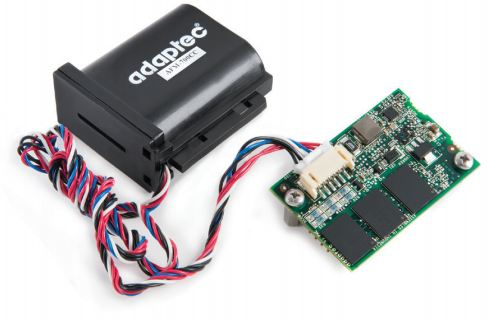 MICROCHIP TECHNOLOGY Adaptec Flash Module 700 (AFM-700)
MICROCHIP TECHNOLOGY Adaptec Flash Module 700 (AFM-700)
For personal help or faster delivery
+32 2 558 30 00
Enabling the onboard cache on a RAID adapter card signi cantly enhances performance — especially in RAID 5 and RAID 6 scenarios — by accommodating both read caching and write caching of data. But data stored in the cache for write caching can be lost if the cache is not protected against a power or system failure. Lithium-ion (Li-ion) battery backup units (BBUs) are traditionally employed to protect cached data on RAID adapters. Once installed, a new BBU will take several hours to reach a full charge. During the charge cycle, write cache is unprotected (i.e. turned o ), which adversly a ects the RAID adapter’s performance. A typical BBU requires routine capacity testing and performs sub-optimally during those test periods. Lastly, a fully-charged BBU can only preserve data for a maximum of 72 hours during a power loss before the battery power depletes.
Li-ion BBUs have hidden costs that can drastically increase a RAID adapter’s Total Cost of Ownership (TCO) by hundreds of dollars per year through monitoring, maintenance, replacement, and disposal expenses
Zero-Maintenance Cache Protection
Now in its third generation, Adaptec Zero- Maintenance Cache Protection (ZMCP) drastically reduces a RAID adapter’s TCO through the use of ash memory versus Li-ion batteris. ese ash modules provide full protection of cached data without the costs associated with Li-ion batteries.
ZMCP is available for Adaptec Series 7 adapters (72405, 71685, 71605, 7805) as an optional Adaptec Flash Module (AFM-700) and is preinstalled on all Series 7Q models supporting Adaptec’s maxCache 3.0 SSD caching feature. e modular aspect of the AFM-700 gives data centers the exibility of adding ZMCP at any time, depending on their needs and budgetary parameters.
Competitive alternatives force data centers to purchase a new card in order to add cache protection, as certain functionality is built into their base adapter.
The AFM-700 features 2GB of NAND flash memory and super capacitor technology that work together to save cached data in the event of system power loss. e super capacitor charges while the system is booting to provide instant cache protection upon startup. When the module detects loss of power, the super capacitor keeps critical parts of the RAID adapter active long enough to allow data to be copied from the onboard adapter cache to the ash memory.
Once the data has been copied, the ash memory can store it for years without power. When power is returned to the RAID adapter, the data in the ash memory is copied back to the onboard adapter cache and operation resumes as normal with all outstanding I/O requests intact.
Lastly, with its new monitoring features (Real-time Health and Instant Capacity Monitoring), data center administrators can instantly check the temperature, capacity and remaining lifetime of the super capacitor through Adaptec maxView Storage Manager, a web-based interface that makes it simple to view, monitor, and con gure all Adaptec RAID adapters in a system, without disrupting operations or impacting performance.
Results 0
- Reviews
- Write Review
- Questions and Answers
- Ask Question

















 FREE Shipping.
FREE Shipping.

